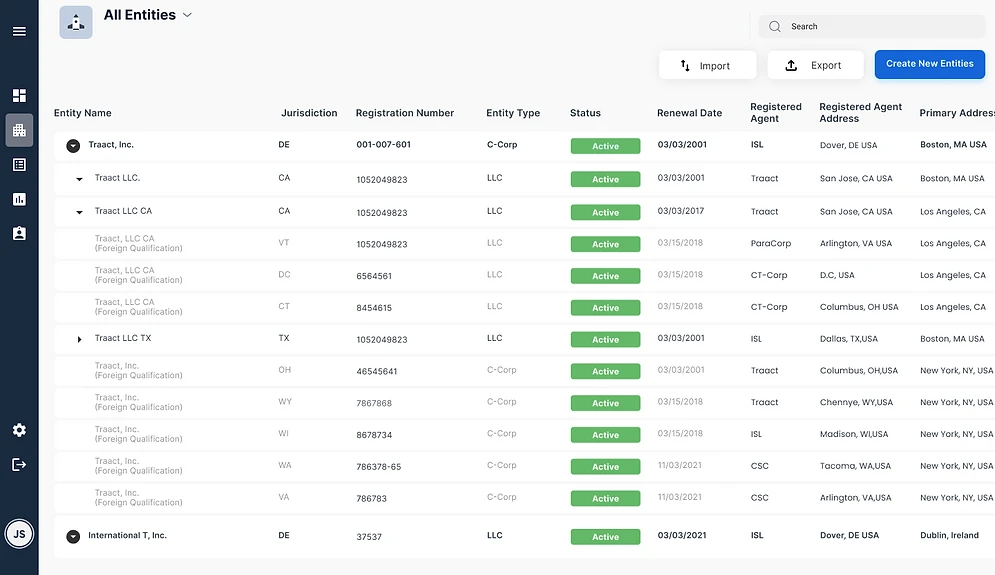How a Unified Entity Management Software Can Help Organize and Use Information
Nov 29, 2022

As businesses grow, the need for a well-organized and centralized system to manage all its various entities also grows. The legal team is often assigned with filing, managing and tracking corporate entities, as well as handling risks, deadlines, and other compliance responsibilities. This is where an entity management system (EMS) comes in.
An EMS software application helps businesses manage their company structures, financials, contracts, employees, and other vital data. With a centralized system to track all this information, companies can avoid common problems such as duplicate entries, inconsistency across departments, and missed deadlines.
Many enterprises are rich in data collection but need to improve managing that information. In addition, the data they may use in their day-to-day operations needs to be organized to provide helpful information. So, how do you get your in-house legal team to do more with an Entity Management System? The system can manage data efficiently and provide an easy means of viewing what is needed for an entity to comply with the rules of a specific jurisdiction. Let's take a look at some benefits:
It's a time saver
Entity managers are assigned many tasks and are often requested to furnish reports. Unfortunately, this takes away their valuable time that should ideally be spent on managing entities. Furthermore, this results in missing out on deadlines to file for new entities or do the paperwork for those about to expire.
One significant advantage of an entity management system is efficiency boost - file and report quickly, automate segments of workflows and use notifications and calendars to nudge stakeholders to take action. EMS gives the entity manager more time to be proactive about management and compliance instead of running two steps behind.
Calendar notifications to ensure deadlines are met
An essential feature of a unified entity management system is a calendar based on RAG status or a task that also notifies an entity manager or a legal professional about an upcoming renewal or expiring document. In addition, the dashboard highlights when a filing is due, brings risk issues to the fore, and alerts stakeholders when it's their turn in the workflow.
Workflows become efficient and streamlined
EMS adds enhanced efficiency and streamlines compliance workflows, with the end of the process including automated filings to local regulators as required. Legal operations teams and compliance managers can help ensure compliance for each entity without scrambling for details across multiple systems by automating filing based on better-quality entity data and more accurate corporate records.
Acquire better-quality data
When entity data is stored securely on a centralized cloud service, it is protected from cybersecurity challenges. As a result, there is less risk of human error or replication being introduced to the corporate record, meaning the entity data accessed for reports is precise, up-to-date and of a higher grade than manually managed data. In addition, entity data organized in a systematic order using an EMS poses less risk of non-compliance and streamlines the audit process.
Easy access to data
An entity management system provides a secure online space for stakeholders to access and review the company's crucial information. This saves the Head of IT from having to set up secure corporate accounts for outside parties and makes it easy for them to get the information they need.
Decision-makers have the most up-to-date and relevant information at their fingertips, allowing them to make informed decisions quickly. Additionally, all stakeholders can work concurrently on the same document or dataset without having to worry about version control.
Data under one hood
Data fragmentation issues are relevant across companies, due to which the legal team is saddled with managing discrepancies making them lose out on valuable time and energy. From the compliance team to the Board, any and everyone involved with entity management can view the same dataset from the same source. This is made possible using an entity management system. EMS enables the right people to access the correct information at the right time and helps to ensure compliance across all entities under management. The system breaks down data silos, provides scalability, encourages innovation, and gets decision-makers what they need.
In a nutshell, Entity Management System allows the legal team to centralize, manage and effectively structure the corporate record using cloud technology. Apart from securely storing vital information, the system also helps generate reports for governance and compliance requirements. It helps you file and submit forms directly from your dashboard with the concerned regulatory bodies. Additionally, the entity management system allows you to integrate the Board to share documents securely. Lastly, the calendar notifications let the legal team stay updated with the contracts, permits, and license renewal cycle.
Traact is a new-age SaaS-based platform that simplifies legal entity management, empowering the legal team to be more efficient and reduce the risks involved with compliance. Book a free demo to learn how Traact can help you manage entities.